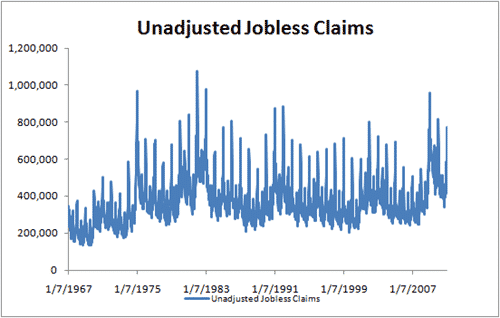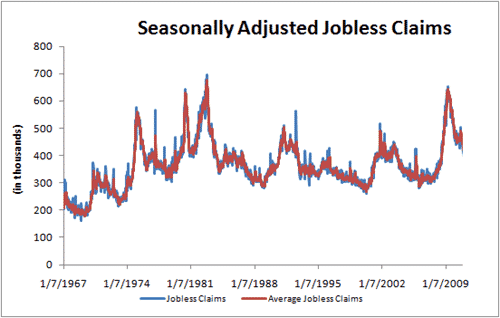Jan 13, 2011
The number of first-time claims for unemployment insurance payments jumped in the first week of 2011 to the highest level since October as more Americans lined up to file following the holidays.
Initial jobless claims rose by 35,000 to 445,000, according to Labor Department data released today. The median estimate in a Bloomberg News survey called for 410,000 filings. The average number of applications over the past four weeks, a less-volatile gauge, increased to 416,500.
Today’s figures follow a report last week showing the U.S. added fewer jobs than forecast in December, underscoring the concern of Federal Reserve policy makers about the labor market. Economic growth may need to accelerate further and encourage companies to ramp up the hiring necessary to reduce the unemployment rate.
“Firms won’t go out and hire a lot of people until they’re confident that demand is increasing,” Scott Brown, chief economist at Raymond James & Associates Inc. in St. Petersburg, Florida, said before the report. “Demand is improving but it isn’t enough.”
The Bloomberg median forecast was based on 46 economists’ projections that ranged from 380,000 to 420,000. The increase from the previous week was the biggest since July 17.
The first week of the year is “historically the highest week for claims,” before seasonal adjustment, because of the Christmas and New Year’s holidays, a Labor Department spokesman said as the figures were released. He said that the four-week average for claims was a more useful measure.
While the Labor Department adjusts for a large pickup in filings around the start of a year, actual applications for jobless benefits were even higher, he said.
Continuing Claims
The number of people continuing to receive jobless benefits fell by 248,000 in the week ended Jan. 1 to 3.88 million, the lowest level since Oct. 25, 2008. The continuing claims figure does not include the number of Americans receiving extended benefits under federal programs.
Those who’ve use up their traditional benefits and are now collecting emergency and extended payments increased by about 128,000 to 4.64 million in the week ended Dec. 25.
The unemployment rate among people eligible for benefits fell to 3.1 percent in the week ended Jan. 1, from 3.3 percent the prior week, today’s report showed.
Thirty-four states and territories reported an increase in first-time unemployment claims for the week ended Jan. 1, while 19 had a decrease.
Initial jobless claims reflect weekly firings and tend to fall as job growth -- measured by the monthly non-farm payrolls report -- accelerates.
Fed’s Bernanke
Fed Chairman Ben S. Bernanke last week said the unemployment rate will probably fall slowly even with a pickup in U.S. growth this year.
At the pace of improvement projected by Fed officials, “it could take four to five more years for the job market to normalize fully,” Bernanke said Jan. 7 in testimony to the Senate Budget Committee.
The U.S. added 103,000 jobs in December, fewer than economists had forecast in a Bloomberg survey, according to Labor Department data released Jan. 7. The unemployment rate fell to 9.4 percent, from 9.8 percent a month earlier, partly because fewer people were in the labor force.
Synovus Financial Corp., a Columbus, Georgia-based bank, on Jan. 10 said it plans to cut about another 850 positions this year to streamline operations and save money. The company eliminated 300 jobs in 2010.
Some companies are hiring. Ford Motor Co. said Jan. 10 it plans to hire more than 7,000 workers in the next two years, including engineers with expertise in battery-powered cars.
Ford will hire 4,000 factory workers and 750 engineers this year and add 2,500 hourly workers next year, Mark Truby, a company spokesman, said in an interview in Detroit.
The number of first-time claims for unemployment insurance payments jumped in the first week of 2011 to the highest level since October as more Americans lined up to file following the holidays.
Initial jobless claims rose by 35,000 to 445,000, according to Labor Department data released today. The median estimate in a Bloomberg News survey called for 410,000 filings. The average number of applications over the past four weeks, a less-volatile gauge, increased to 416,500.
Today’s figures follow a report last week showing the U.S. added fewer jobs than forecast in December, underscoring the concern of Federal Reserve policy makers about the labor market. Economic growth may need to accelerate further and encourage companies to ramp up the hiring necessary to reduce the unemployment rate.
“Firms won’t go out and hire a lot of people until they’re confident that demand is increasing,” Scott Brown, chief economist at Raymond James & Associates Inc. in St. Petersburg, Florida, said before the report. “Demand is improving but it isn’t enough.”
The Bloomberg median forecast was based on 46 economists’ projections that ranged from 380,000 to 420,000. The increase from the previous week was the biggest since July 17.
The first week of the year is “historically the highest week for claims,” before seasonal adjustment, because of the Christmas and New Year’s holidays, a Labor Department spokesman said as the figures were released. He said that the four-week average for claims was a more useful measure.
While the Labor Department adjusts for a large pickup in filings around the start of a year, actual applications for jobless benefits were even higher, he said.
Continuing Claims
The number of people continuing to receive jobless benefits fell by 248,000 in the week ended Jan. 1 to 3.88 million, the lowest level since Oct. 25, 2008. The continuing claims figure does not include the number of Americans receiving extended benefits under federal programs.
Those who’ve use up their traditional benefits and are now collecting emergency and extended payments increased by about 128,000 to 4.64 million in the week ended Dec. 25.
The unemployment rate among people eligible for benefits fell to 3.1 percent in the week ended Jan. 1, from 3.3 percent the prior week, today’s report showed.
Thirty-four states and territories reported an increase in first-time unemployment claims for the week ended Jan. 1, while 19 had a decrease.
Initial jobless claims reflect weekly firings and tend to fall as job growth -- measured by the monthly non-farm payrolls report -- accelerates.
Fed’s Bernanke
Fed Chairman Ben S. Bernanke last week said the unemployment rate will probably fall slowly even with a pickup in U.S. growth this year.
At the pace of improvement projected by Fed officials, “it could take four to five more years for the job market to normalize fully,” Bernanke said Jan. 7 in testimony to the Senate Budget Committee.
The U.S. added 103,000 jobs in December, fewer than economists had forecast in a Bloomberg survey, according to Labor Department data released Jan. 7. The unemployment rate fell to 9.4 percent, from 9.8 percent a month earlier, partly because fewer people were in the labor force.
Synovus Financial Corp., a Columbus, Georgia-based bank, on Jan. 10 said it plans to cut about another 850 positions this year to streamline operations and save money. The company eliminated 300 jobs in 2010.
Some companies are hiring. Ford Motor Co. said Jan. 10 it plans to hire more than 7,000 workers in the next two years, including engineers with expertise in battery-powered cars.
Ford will hire 4,000 factory workers and 750 engineers this year and add 2,500 hourly workers next year, Mark Truby, a company spokesman, said in an interview in Detroit.


 MAKE SURE AND VISIT Tobee's Blogs!
MAKE SURE AND VISIT Tobee's Blogs!  341 Meeting 12-16-2010
341 Meeting 12-16-2010 



Comment